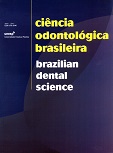Microinfiltração de materiais restauradores temporários usados durante o clareamento dental interno
DOI:
https://doi.org/10.14295/bds.2007.v10i4.275Abstract
O objetivo deste estudo foi avaliar a capacidade de diferentes materiais seladores temporários em prevenir a microinfiltração coronária durante o clareamento de dentes tratados endodonticamente. Foram utilizados 70 molares humanos íntegros que receberam abertura coronária padronizada e terapia simulando a técnica de clareamento. Os dentes foram divididos em 8 grupos (6 grupos experimentais e 2 grupos controle); sendo que nos grupos experimentais as cavidades de acesso foram seladas com Cavit (ESPE), Resina Composta TPH (Denstply), Cimento de Ionômero de Vidro (Vidrion R – SSWhite), IRM (Dentsply), Cimpat (Septodont) ou Cavitec (Kerr). O grupo controle negativo não recebeu abertura de acesso e no controle positivo as aberturas de acesso não foram restauradas. Os dentes foram termociclados (5ºC a 55ºC, 300 ciclos) e a microinfiltração foi medida linearmente pela extensão de penetração do corante azul de metileno 2%. As medidas das infiltrações foram avaliadas pelo modelo estatístico de Conover e pelo teste de Tukey (5%). Os resultados mostraram melhor capacidade de selamento oferecida pelo Cimento de Ionômero de Vidro, Resina Composta e Cimpat, sem diferenças estatisticamente significantes (p > 0,01). Os maiores valores de infiltração foram verificadas com o IRM. Conclui-se que o cimento ionômero de vidro, a resina composta e o Cimpat são capazes de minimizar a microinfiltração e portanto podem ser utilizados como seladores temporários durante o clareamento.Downloads
Downloads
Published
How to Cite
Issue
Section
License
Brazilian Dental Science uses the Creative Commons (CC-BY 4.0) license, thus preserving the integrity of articles in an open access environment. The journal allows the author to retain publishing rights without restrictions.
=================




























